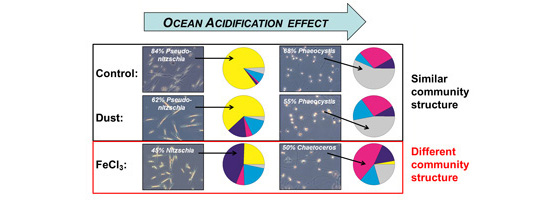Natural iron input scenarios are required to project future biological CO2 sequestration by the Southern Ocean

The rise in anthropogenic CO2 and the associated ocean acidification (OA) will change trace metal solubility and speciation, potentially altering Southern Ocean (SO) phytoplankton productivity and species composition. As iron (Fe) sources are important determinants of Fe bioavailability, we assessed the effect of Fe-laden dust versus inorganic Fe (FeCl3) enrichment under ambient and high pCO2 levels (390 and 900 µatm) in a naturally Fe-limited SO phytoplankton community. Despite similar Fe chemical speciation and net particulate organic carbon (POC) production rates, CO2-dependent species shifts were controlled by Fe sources. Final phytoplankton communities of both control and dust treatments were dominated by the same species, with an OA-dependent shift from the diatom Pseudo-nitzschia prolongatoides towardsthe prymnesiophyte Phaeocystis antarctica.Addition ofFeCl3 resulted in high abundances ofNitzschia lecointei and Chaetoceros neogracilis under ambient and high pCO2, respectively. These findings reveal that both the characterization of the phytoplankton community at the species level and the use of natural Fe sources are essential for a realistic projection of the biological carbon pump in the Fe-limited pelagic SO under OA. As dust deposition represents a more realistic scenario for the Fe-limited pelagic SO under OA, unaffected net POC production and dominance of P. antarctica can potentially weaken the export of carbon and silica in the future.
Trimborn, S., Brenneis, T., Hoppe, C., Laglera Baquer, L.M., Norman, L., Santos-Echeandia, J., Völkner, C., Wolf-Gladrow, D., and Hassler, C., 2017, Iron sources alter the response of Southern Ocean phytoplankton to ocean acidification: Marine Ecology Progress Series.
20 Jul 2017
